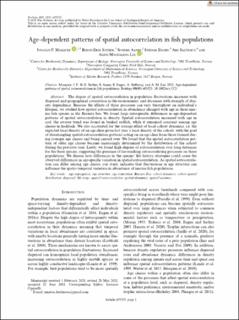| dc.contributor.author | Marquez, Jonatan | |
| dc.contributor.author | Sæther, Bernt-Erik | |
| dc.contributor.author | Aanes, Sondre | |
| dc.contributor.author | Engen, Steinar | |
| dc.contributor.author | Salthaug, Are | |
| dc.contributor.author | Lee, Aline Magdalena | |
| dc.date.accessioned | 2021-10-28T09:12:27Z | |
| dc.date.available | 2021-10-28T09:12:27Z | |
| dc.date.created | 2021-10-06T12:30:49Z | |
| dc.date.issued | 2021 | |
| dc.identifier.citation | Ecology. 2021, 00:e03523 1-13. | en_US |
| dc.identifier.issn | 0012-9658 | |
| dc.identifier.uri | https://hdl.handle.net/11250/2826225 | |
| dc.description.abstract | The degree of spatial autocorrelation in population fluctuations increases with dispersal and geographical covariation in the environment, and decreases with strength of density dependence. Because the effects of these processes can vary throughout an individual’s lifespan, we studied how spatial autocorrelation in abundance changed with age in three marine fish species in the Barents Sea. We found large interspecific differences in age-dependent patterns of spatial autocorrelation in density. Spatial autocorrelation increased with age in cod, the reverse trend was found in beaked redfish, while it remained constant among age classes in haddock. We also accounted for the average effect of local cohort dynamics, i.e. the expected local density of an age class given last year’s local density of the cohort, with the goal of disentangling spatial autocorrelation patterns acting on an age class from those formed during younger age classes and being carried over. We found that the spatial autocorrelation pattern of older age classes became increasingly determined by the distribution of the cohort during the previous year. Lastly, we found high degrees of autocorrelation over long distances for the three species, suggesting the presence of far-reaching autocorrelating processes on these populations. We discuss how differences in the species’ life history strategies could cause the observed differences in age-specific variation in spatial autocorrelation. As spatial autocorrelation can differ among age classes, our study indicates that fluctuations in age structure can influence the spatio-temporal variation in abundance of marine fish populations. | en_US |
| dc.language.iso | eng | en_US |
| dc.publisher | Wiley | en_US |
| dc.rights | Attribution-NonCommercial-NoDerivatives 4.0 Internasjonal | * |
| dc.rights.uri | http://creativecommons.org/licenses/by-nc-nd/4.0/deed.no | * |
| dc.title | Age-dependent patterns of spatial autocorrelation in fish populations | en_US |
| dc.type | Journal article | en_US |
| dc.type | Peer reviewed | en_US |
| dc.description.version | publishedVersion | en_US |
| dc.source.pagenumber | 1-13 | en_US |
| dc.source.volume | 00:e03523 | en_US |
| dc.source.journal | Ecology | en_US |
| dc.identifier.doi | 10.1002/ecy.3523 | |
| dc.identifier.cristin | 1943751 | |
| dc.relation.project | Norges forskningsråd: 223257 | en_US |
| dc.relation.project | Norges forskningsråd: 244647 | en_US |
| cristin.ispublished | true | |
| cristin.fulltext | original | |
| cristin.qualitycode | 2 | |

